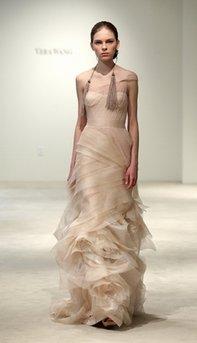
New York – For the major bridal houses in New York, the spring and fall bridal markets are a semi-annual tradition. However, after a few presentations of cream or white satin trumpet gowns and tulle-covered ball gowns with just a few slight variations, showing this often can seem redundant.
One designer, however, who has consistently reinvented bridal since her company's inception in 1990, is Vera Wang. Her latest collection for Spring 2011, shown in New York on Tuesday, April 13, was the latest exhibition of her artistry.
Armed with a thorough knowledge of couture techniques from the past, Wang propels the form forward as she develops new techniques. She'll make organza look ever lighter with her draping, shape silk into sculpture or use tulle as a canvas for hand-printed blossoms or lace, all of which her spring collection featured.
Taking the "fragile femininity" of the garden or tea party as her starting point, her tightly edited collection introduced just 11 new gowns, but each with its own carefully constructed identity.
Starting with the first dress, a hand-printed blush Chantilly organza mermaid gown with one shoulder that delicately whispered over the arm, it was clear that not all bridal dress terminology is created equal when it comes to Vera Wang. This mermaid gown hardly resembled the usual stiff satin silhouettes one usually associates with the term. Instead, Wang's version of the flange skirt looked like an organza rendering of a Japanese woodblock depicting a frothy wave.
In another dress, it was the smallest detail that made the entire dress sing, like a pale lilac gown that had subtle sensual touches: a shoulder strap falling down, or an "illusion" corset peeking through, as though the bride and groom had slipped off for a clandestine moment in the garden. With the barely-there color, Wang aimed for an Easter egg effect, with colors glazing a smooth eggshell-like surface.
As one might guess in this ode to the garden, there were plenty of floral elements, from hand-cut petal embroidery on a bodice to twists of tulle fashioned into oversized blossoms that floated on a draped skirt like a tossed bouquet.
But most stunning were the architectural gowns employing what Wang's program notes termed a "ladder technique": a fabric fractal made up of cascading layers of gravity-defying silk gazar that were like a mad mathematical epiphany transformed into art. Turns out there might be a reason to study calculus after all.





